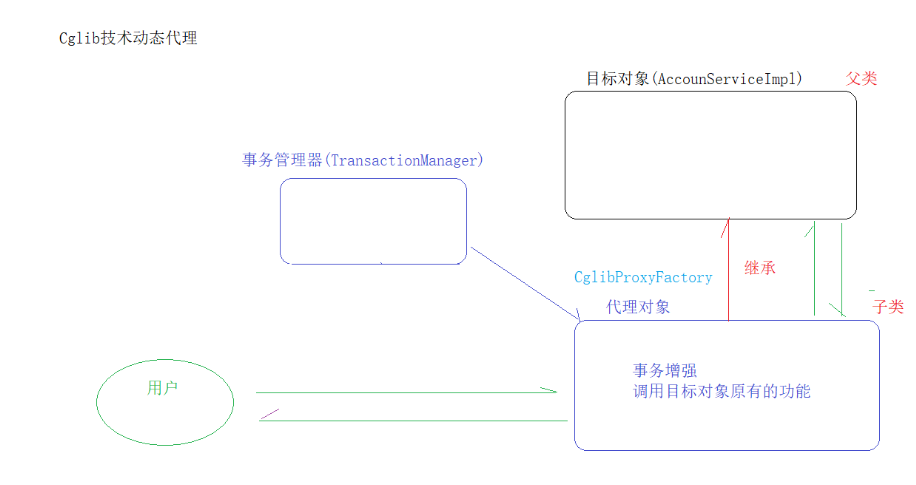Spring AOP&jdbcTemplate
1 sping的aop
1:aop的底层--动态代理(理解)
2: 使用spring提供好的aop做业务增强( xml 半xml半注解 )
2 spring提供的dao操作数据库的手段--JDBCTemplate
一 转账案例
业务代码和事务代码进行拆分,通过动态代理的方式,对业务方法进行事务的增强。这样就不会对业务层产生影响,解决了耦合性的问题啦!(在不修该原方法的基础上,对原方法进行增强)
常用的动态代理技术
JDK 代理 : 基于接口的动态代理技术
条件:必须要有接口
生成的动态代理对象和被代理对象是兄弟关系
CGLIB代理:基于父类的动态代理技术
条件:被代理对象不能使用final修饰
导入cglib的坐标(spring坐标整合好了)
生成的动态代理对象是被代理对象的子类

1)JDK动态代理

JdkProxy
/**
* jdk动态代理技术工厂
*/
@Component
public class JdkProxy {
@Autowired
@Qualifier("accountServiceImpl")
private AccountService accountService;
@Autowired
private TransactionManager transactionManager;
@Bean("AccountServiceProxy")
public Object getProxy(){
Object objProxy = Proxy.newProxyInstance(accountService.getClass().getClassLoader(),
accountService.getClass().getInterfaces(),
new InvocationHandler() {
@Override
public Object invoke(Object proxy, Method method, Object[] args) throws Throwable {
Object value=null;
try {
transactionManager.begin();
value = method.invoke(accountService, args);
transactionManager.commit();
}catch (Exception e){
e.printStackTrace();
transactionManager.rollback();
}finally {
transactionManager.close();
}
return value;
}
});
return objProxy;
}
}
SpringJunitTest
@RunWith(SpringJUnit4ClassRunner.class)
@ContextConfiguration(locations = "classpath:application.xml")
public class SpringJunitTest2 {
@Autowired
@Qualifier("AccountServiceProxy") //代理对象--jdk
private AccountService accountService;
@Test
public void test1() throws SQLException {
accountService.tranfer();
}
}
2)Cglib动态代理
spring的jar包,是包含cglib依赖

CglibProxy
@Component
public class CglibProxy {
@Autowired
@Qualifier("accountServiceImpl")
private AccountServiceImpl accountService;
@Autowired
private TransactionManager transactionManager;
@Bean("accountProxy")
public Object getCglibProxy(){
Object object =Enhancer.create(accountService.getClass(), new MethodInterceptor() {
@Override
public Object intercept(Object o, Method method, Object[] objects, MethodProxy methodProxy) throws Throwable {
Object value = null;
try {
transactionManager.begin();
value = methodProxy.invoke(accountService, objects);
transactionManager.commit();
} catch (Exception e) {
e.printStackTrace();
transactionManager.rollback();
} finally {
transactionManager.close();
}
return value;
}
});
return object;
}
}
SpringJunitTest
@RunWith(SpringJUnit4ClassRunner.class)
@ContextConfiguration(locations = "classpath:application.xml")
public class SpringJunitTest2 {
@Autowired
@Qualifier("accountProxy") //代理对象--cglib
private AccountServiceImpl accountService;
@Test
public void test1() throws SQLException {
accountService.tranfer();
}
}
二 Spring的AOP简介
AOP:面向切面编程是软件开发的一种思想
目的:代码之间的解耦,在不破坏源代码的情况下,对源代码实现业务增强。
springAOP的底层:动态代理
springAOP的相关术语
Target(目标对象): 要被增强的对象
Proxy(代理对象) : 对增强对象的封装对象
Joinpoint(连接点): 目标对象的一个一个方法
Pointcut(切入点): 目标对象要被增强的那个方法
Advice(通知/增强): 增强方法
前置通知
后置通知
异常通知
最终通知
环绕通知
Aspect(切面): 切入点+通知=切面 (目标方法和增强方法合成在一起 叫做切面)
Weaving(织入):将切入点集成到切面的这一个过程 我们称为织入过程
将目标方法和增强方法合成在一起的过程 叫织入过程 (底层实现技术就是动态代理)
三 基于XML的AOP开发【重点】
导入坐标
<dependency>
<groupId>org.aspectj</groupId>
<artifactId>aspectjweaver</artifactId>
<version>1.8.13</version>
</dependency>
<!--通知类-->
<bean id="adviceConfig" class="cn.itcast.advice.AdviceConfig"></bean>
<!--spring的aop:
关注点1:通知(增强方法)
关注点2:织入(将通知和切入点合并成切面的过程) 使用aop标签
// 将增强方法和目标方法合同在一起的过程
-->
<!--aop的置入-->
<aop:config>
<!--指向通知-->
<aop:aspect ref="adviceConfig">
<!--
before:之前
method:通知类中的某个方法
pointcut:指向的是切入点(要增强的方法)
表达式:
execution(public void cn.itcast.serviceimpl.AccountServiceImpl.save(..))
修饰符:可以省略不写
返回值:可以使用通配符
包名:cn.itcast.serviceimpl
可以使用通配符代替 但是只能代替一个
类名:AccountServiceImpl
可以使用通配符代替 但是只能代替一个
方法名:save(..)
可以使用通配符代替 但是只能代替一个
通配符:* 可以代替所有
..:用于方法参数 用于包名
方法参数:代表参数可有可无
包名:cn.. 带表cn下的所有子包 cn.itcast.. 带表是cn.itcast下的所有子包
-->
<!--抽取切入点-->
<aop:pointcut id="pt" expression="execution(* cn.itcast.*.AccountServiceImpl.*(..))"></aop:pointcut>
<!--前置 后置 异常 最终 顺序无序 建议单独使用-->
<aop:before method="before" pointcut-ref="pt"></aop:before>
<aop:after-returning method="afterReturning" pointcut-ref="pt"></aop:after-returning>
<aop:after-throwing method="afterThrowing" pointcut-ref="pt"></aop:after-throwing>
<aop:after method="after" pointcut-ref="pt"></aop:after>
<!--环绕通知-->
<!-- <aop:around method="around" pointcut="execution(public void cn.itcast.serviceimpl.AccountServiceImpl.save(..))"></aop:around>-->
</aop:aspect>
</aop:config>
四 基于注解的AOP开发
1 开启aop的注解
<aop:aspectj-autoproxy></aop:aspectj-autoproxy>
2 在通知类添加注解
@Aspect
public class AdviceConfig {
....
}
3 在每个通知方法上添加切入点表达式
public class AdviceConfig {
/*抽取切入点表达式:
* 定义无参无返回值无内容的方法
* 在方法头上加统一注解:@Pointcut("execution(* cn.itcast.*.AccountServiceImpl.save(..))")
* 谁用谁调方法名
*
* */
@Pointcut("execution(* cn.itcast.*.AccountServiceImpl.save(..))")
public void pt(){}
//通知
//@Before("pt()")
public void before(){
System.out.println("之前。。。");
}
//通知
//@AfterReturning("pt()")
public void afterReturning(){
System.out.println("之后。。。");
}
//通知
//@AfterThrowing("pt()")
public void afterThrowing(){
System.out.println("异常。。。");
}
//通知
//@After("pt()")
public void after(){
System.out.println("最终。。。");
}
// 通知--给环绕用
@Around("pt()")
public void around(ProceedingJoinPoint pj){
try {
// 之前
System.out.println("之前。。。");
// 原方法
pj.proceed(); //invoke
// 之后
System.out.println("之后。。。");
}catch (Throwable e){
e.printStackTrace();
System.out.println("异常。。。");
}finally {
System.out.println("最终。。。");
}
}
}
4 抽取切入点表达式
/*抽取切入点表达式:
* 定义无参无返回值无内容的方法
* 在方法头上加统一注解:@Pointcut("execution(* cn.itcast.*.AccountServiceImpl.save(..))")
* 谁用谁调方法名
*
* */
@Pointcut("execution(* cn.itcast.*.AccountServiceImpl.save(..))")
public void pt(){}
// 通知--给环绕用
@Around("pt()")
public void around(ProceedingJoinPoint pj){
try {
// 之前
System.out.println("之前。。。");
// 原方法
pj.proceed(); //invoke
// 之后
System.out.println("之后。。。");
}catch (Throwable e){
e.printStackTrace();
System.out.println("异常。。。");
}finally {
System.out.println("最终。。。");
}
}
全注解开发:
@EnableAspectJAutoProxy 配置类上填写该注解 会扫描带有Aspect注解的内容
@Configuration
@ComponentScan(basePackages = "cn.itcast")
@EnableAspectJAutoProxy
public class SpringConfig {
}
五 spring的aop优化转账
1 aop的全xml方式
application.xml
<!--aop的xml方式:
关注点:通知
关注点:织入
-->
<bean id="transactionManager" class="cn.itcast.utils.TransactionManager"></bean>
<aop:config>
<aop:aspect ref="transactionManager">
<aop:pointcut id="pt" expression="execution(* cn.itcast.serviceimpl.AccountServiceImpl.tranfer(..))"></aop:pointcut>
<aop:around method="around" pointcut-ref="pt"></aop:around>
</aop:aspect>
</aop:config>
TransactionManager
public void around(ProceedingJoinPoint pjp){
try {
begin();
pjp.proceed();
commit();
} catch (Throwable throwable) {
throwable.printStackTrace();
rollback();
}finally {
close();
}
}
2 aop的半xml半注解方式
application.xml
<aop:aspectj-autoproxy></aop:aspectj-autoproxy>
TransactionManager
@Component
@Aspect
public class TransactionManager {
@Autowired
private ThreadLocalUtils tl;
// 开启事务
public void begin(){
try {
tl.getConnection().setAutoCommit(false);
} catch (SQLException e) {
e.printStackTrace();
}
}
// 提交事务
public void commit(){
try {
tl.getConnection().commit();
} catch (SQLException e) {
e.printStackTrace();
}
}
// 回滚事务
public void rollback(){
try {
tl.getConnection().rollback();
} catch (SQLException e) {
e.printStackTrace();
}
}
// 释放资源
public void close(){
try {
tl.getConnection().close();
} catch (SQLException e) {
e.printStackTrace();
}
}
@Pointcut("execution(* cn.itcast.serviceimpl.AccountServiceImpl.tranfer(..))")
public void pt(){}
@Around("pt()")
public void around(ProceedingJoinPoint pjp){
try {
begin();
pjp.proceed();
commit();
} catch (Throwable throwable) {
throwable.printStackTrace();
rollback();
}finally {
close();
}
}
}
六 spring整合JdbcTemplate
jdbcTemplate:spring提供的用来操作数据库的工具
构造:new JdbcTemplate(连接池)
api:
update() 增删改
queryForObject() 单查
query()多查
整合步骤
1 导入jdbcTemplate的坐标
<!--jdbcTemplate-->
<dependency>
<groupId>org.springframework</groupId>
<artifactId>spring-jdbc</artifactId>
<version>5.1.5.RELEASE</version>
</dependency>
<dependency>
<groupId>org.springframework</groupId>
<artifactId>spring-tx</artifactId>
<version>5.1.5.RELEASE</version>
</dependency>
2 整合jdbcTemplate(application.xml)
<?xml version="1.0" encoding="UTF-8"?>
<beans xmlns="http://www.springframework.org/schema/beans"
xmlns:context="http://www.springframework.org/schema/context"
xmlns:xsi="http://www.w3.org/2001/XMLSchema-instance"
xsi:schemaLocation="http://www.springframework.org/schema/beans http://www.springframework.org/schema/beans/spring-beans.xsd
http://www.springframework.org/schema/context
http://www.springframework.org/schema/context/spring-context.xsd">
<!--开启注解扫描-->
<context:component-scan base-package="cn.itcast"></context:component-scan>
<!--第三方的资源-->
<bean id="jdbcTemplate" class="org.springframework.jdbc.core.JdbcTemplate">
<property name="dataSource" ref="druid"></property>
</bean>
<!--druid-->
<context:property-placeholder location="classpath:jdbc.properties"></context:property-placeholder>
<bean id="druid" class="com.alibaba.druid.pool.DruidDataSource">
<property name="driverClassName" value="${jdbc.driver}"></property>
<property name="url" value="${jdbc.url}"></property>
<property name="username" value="${jdbc.username}"></property>
<property name="password" value="${jdbc.password}"></property>
</bean>
</beans>
AccountDaoImpl
@Repository
public class AccountDaoImpl implements AccountDao {
@Autowired
private JdbcTemplate jdbcTemplate;
@Override
public void save() {
/*增加
String sql="insert into account(name,money) values(?,?)";
jdbcTemplate.update(sql,"老王2",100);*/
//单查询--返回对象
/*String sql="select * from account where id=?";
Account account = jdbcTemplate.queryForObject(sql, new BeanPropertyRowMapper<Account>(Account.class), 1);
System.out.println(account);*/
//多查--返回list
String sql="select * from account";
List<Account> list = jdbcTemplate.query(sql, new BeanPropertyRowMapper<Account>(Account.class));
for (Account account : list) {
System.out.println(account);
}
}
}
SpringJunitTest1测试
@RunWith(SpringJUnit4ClassRunner.class)
@ContextConfiguration(locations = "classpath:application.xml")
public class SpringJunitTest1 {
@Autowired
private AccountService accountService;
@Test
public void test(){
accountService.save();
}
}




















 100
100











 被折叠的 条评论
为什么被折叠?
被折叠的 条评论
为什么被折叠?








